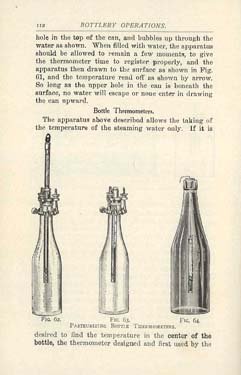Pasteurization
Prior to Louis Pasteur's discovery that heating beer would prolong its shelf life, distribution of beer beyond a small area around a brewery was not possible. Beer is pasteurized in one of two ways: tunnel pasteurization or "flash" pasteurization. In tunnel pasteurization, bottled or canned beer is passed through a tunnel on conveyer belt where they are sprayed with hot water to raise their temperature to 60-62 degrees centigrade. The containers are held at this temperature for 5-15 minutes. In "flash" pasteurization, the beer itself is passed through a heat exchanger to heat and then cool it rapidly before it is packaged in sterilized bottles or cans. This 1906 illustration (right) shows three types of pasteurizing bottle thermometers designed to check that the beer reached appropriate temperatures to insure pasteurization.
Dreesbach, Philip. Beer Bottlers' Handy Book, Profusely Illustrated, Containing also many Figuring Examples, Tables, Bookkeeping Forms and Steaming Charts, Wahl-Henius Institute: Chicago, 1906. Crerar TP659.D77

